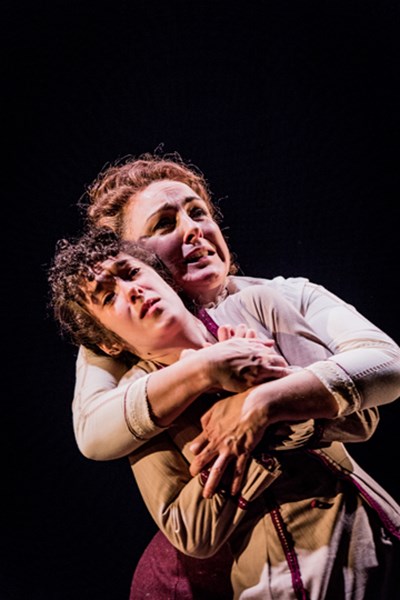Turn of the Screw, by Henry James, is a classic of supernatural literature, in many ways one of the initiators of the ghost story as a literary genre. This new adaptation for the scene, cured by Tim Luscombe, had to come to grips with the implications of dealing with a text that is therefore in many ways iconic, and with a narration that is in itself rather static, relying on atmosphere much more than it does on action. On top of this, one must be mindful of the difficulties of bringing horror, as a genre, to the stage; ghost stories might be thought of as being more suitable to other media, like cinema, with its ability to postproduce and add special effects. The text presented therefore many challenges; this production, relying on a small but dedicated cast, successfully addressed most of them. Especially in the second act, as the ghostly activity is ramped up, the dense, morbid atmosphere that is the most distinctive trait of the original story is effectively recreated; after somewhat of a slow start in the first act, the action becomes gripping and successfully capitalises on what it is probably the strongest point in a theatrical setting – its ambiguity. Like many ghost stories both classic and modern, Turn of the Screw plays with the credibility of its narrator without ever truly solving the matter of whether the paranormal activity is indeed real, or just a figment of the disturbed governess’ imagination. In a visual medium like theatre, it is much harder to preserve this ambiguous nature than it would be on the page; yet in this respect this production fully meets its objective, also thanks to Carli Norris’ performance as the Governess. Her delivery constantly lingers between believable fear and a hint of deranged, making it possible for the audience to read in it whatever interpretation they choose to be the most believable; at the end of the play a viable argument can be made both for the supernatural explanation and the psychological one. This is undoubtedly the play’s greatest strength, and what ultimately makes its narration compelling.
In building its atmosphere, and bringing horror to the stage, the play undoubtedly has a debt, or more fairly a close relationship, with the famous predecessor that is The Woman in Black; a relationship that is acknowledged by Luscombe himself in his writing accompanying the programme. Like The Woman in Black, Turn of the Screw does not openly credit its ghosts, and measures their apparitions carefully, introducing them with a surrounding environment of lighting and sound. This is at its most effective when it’s more subtle; the clever play of stage light and unresolved tension conveys the uncomfortableness of the atmosphere in the house that is the play’s only setting much better than the sudden, loud noises that sometimes accompany the ghosts’ entry, and that are at times at risk of being too much on-the-nose. Conversely, when it plays its atmosphere as a slow build that is often resolved in nothing definite, Turn of the Screw perfectly manages to generate the unnerving feeling that should be the backbone of a narration like this. Daniel Buckroyd’s direction is also clever in handling the transition between the two times of the narration – the presence and the memory; the numerous shifts between one and the other are in most cases artfully delivered, only occasionally coming across, albeit briefly, as contrived.
While Carli Norris’ Governess is undoubtedly the most remarkable presence on scene, dictating the shifts in mood in the play and ultimately carrying responsibility for the duplicity of its possible readings, also worthy of mention are Maggie McCarthy, both subtle and endearing as Mrs Grose, and Annabel Smith, who, while altogether more convincing in her ‘adult’ version of Mrs Conray, also succeeds, more often than not, in the rather difficult challenge of convincingly portraying the moods and behaviours of a child. The play requests a great effort of its small cast, almost continuously on the scene, and it is to their credit that they manage to keep the tension constant throughout.
Turn of the Screw is an entertaining performance that manages, most of the time, to convey the same atmosphere of its literary predecessor, as well as its unresolved nature; under this respect it is the most successful. It is at its best when atmospheric and understated, and less so when it tries to indulge the more jumpy nature of the horror genre. With a capable adaptation and a cast that delivers solid, engaging performances, it can still claim to do justice to the work of Henry James.
Until May 26
http://www.newtheatrecardiff.co.uk/what’s-on/turn-of-the-screw/
